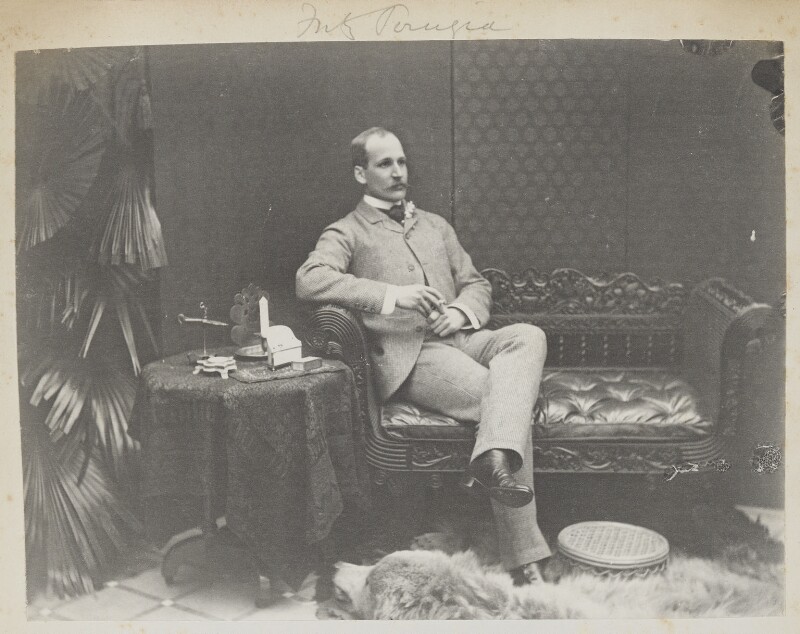When I put together a new edition of an old skating book, I like to include some biographical information about the author in the introduction. Henry C. Lowther, the author of the three little books I’m working on now (Edges and Striking, Principle of Skating Turns, and Combined Figure-Skating) is turning out to be a rather slippery subject.
There were two Henry C. Lowthers alive at the right time to have written the books: Henry Crofton Lowther (1858-1939) and Henry Cecil Lowther (1869-1940). In addition to similar names, they had similar lives. Both were knighted, and both married women named Dorothy. In this article, I’ll call them by their middle names to make it easy to keep track of who is who.
I haven’t been able to find a relationship between the two Lowthers. Cecil was the nephew of the Earl of Lonsdale, and Crofton was the son of Reverend Brabazon Lowther (who was not rich) and Ellen Jane Legh, the only surviving child of Ellen Turner of Shrigley Abduction fame (Ashby and Jones, 189-190).
The big question is, which one wrote the skating books?
In the bibliography to The English Style, James Hines lists the books under the name “Henry Cecil Lowther,” which means he thought Cecil wrote them. Hines doesn’t discuss Lowther in this book or any of his other books, so I can’t say why he picked the Henry he did. I suspect he simply looked the books up in a library catalog, like OCLC WorldCat. WorldCat Identities has the books listed on Cecil’s page. Crofton does not appear in WorldCat.
Elaine Hooper, historian of the National Ice Skating Association—the body that governs figure skating in the UK—thinks the skating Lowther is Crofton because his knighthoods match the knighthoods listed in his membership records exactly (Cecil received different knighthoods) and because two addresses in the NISA’s records match addresses associated with Crofton.
Frances Glover, secretary of the Royal Skating Club, confirmed the identification through membership records. The skating books note that Lowther was a member of the Skating Club, which merged with another club to become the Royal Skating Club in about 1930. The old membership lists include “Sir Henry Crofton Lowther,” who is definitely not Cecil!
So, Crofton wrote the books, but it seems like he has been lost to time. His books have been attributed to Cecil, another man who lived a similar life. It’s time to separate the two men and bring Crofton into the light. Here’s a picture of Sir Henry Crofton Lowther, diplomat, expert skater, and author of three books on skating.

The confusion in WorldCat makes me wonder whether Crofton is actually responsible for any of the other books attributed to Cecil. From Pillar to Post and The Scots Guards in the Great War 1914-1918 were definitely by Cecil, and Old English Silver is about Cecil’s collection. Among the Liars is a short article listed under H. C. Lowther in WorldCat; the index reveals that Cecil wrote it. But some of the others invite questions.
There’s a Report on the Railway Systems of Brasil published in 1904 by H. C. Lowther. Crofton was part of the diplomatic service in Brazil at that time; he could have written it.
The Handbook of the Danish Army (1904) is harder to attribute: Cecil, a military man, and Crofton, the British Minister to Denmark, both seem like possible authors. But Crofton was busy in Brazil at that time; he didn’t take up his post in Denmark until 1913. Cecil was part of the War Office, to which the publication is attributed, which makes him the more likely candidate.
Separating Crofton from Cecil is a good start, but there’s more to the problem. The plot thickens with Geology of the Alexo Mine area, Clergue-Dundonald Twps., District of Cochrane, Ontario, published in 1950—after both Cecil and Crofton had died—by what seems to be yet another H. C. Lowther. Perhaps this is the Colonel Lowther mentioned by Irving Brokaw in connection with Canada and the Connaught Cup (192). How does he fit into the story?
Bibliography
A. Ashby and A. Jones, 2003. The Shrigley Abduction: A Tale of Anguish, Deceit, and Violation of the Domestic Hearth. Stroud: Sutton Publishing.
A. & C. Black, 2019. “Lowther, Sir Henry Crofton” and “Lowther, Maj.-Gen. Sir (Henry) Cecil,” in Who’s Who and Who Was Who. Oxford: Oxford University Press.
I. Brokaw, 1925. The Art of Skating. New York: American Sports Publishing.
Christie, Manson, and Woods, 1930. Old English Silver. London: Christie, Manson, and Woods.
J. R. Hines. 2008. The English Style: Figure Skating’s Oldest Tradition. Westwood, MA: Neponset River Press.
H. C. Lowther. 1900. Principle of Skating Turns.London: Horace Cox.
H. C. Lowther. 1902. Edges and Striking. London: Horace Cox.
H. C. Lowther. 1902. Combined Figure-Skating. London: Horace Cox.
H. C. Lowther, 1904. Handbook of the Danish Army. London: H. M. S. O.
H. C. Lowther, 1904. Report on the Railway Systems of Brasil. London: H. M. S. O.
H. C. Lowther, 1911. From Pillar to Post. London: Edward Arnold.
H. C. Lowther, 1925. The Scots Guard in the Great War 1914-1918. London: J. Murray.
H. C. Lowther, 1950. Geology of the Alexo Mine area, Clergue-Dundonald Twps., District of Cochrane, Ontario.London, Ontario: Department of Geology, University of Western Ontario.


[…] Crofton Lowther is called “Henry Cecil Lowther” repeatedly, but that seems to be a misidentification rather than a […]